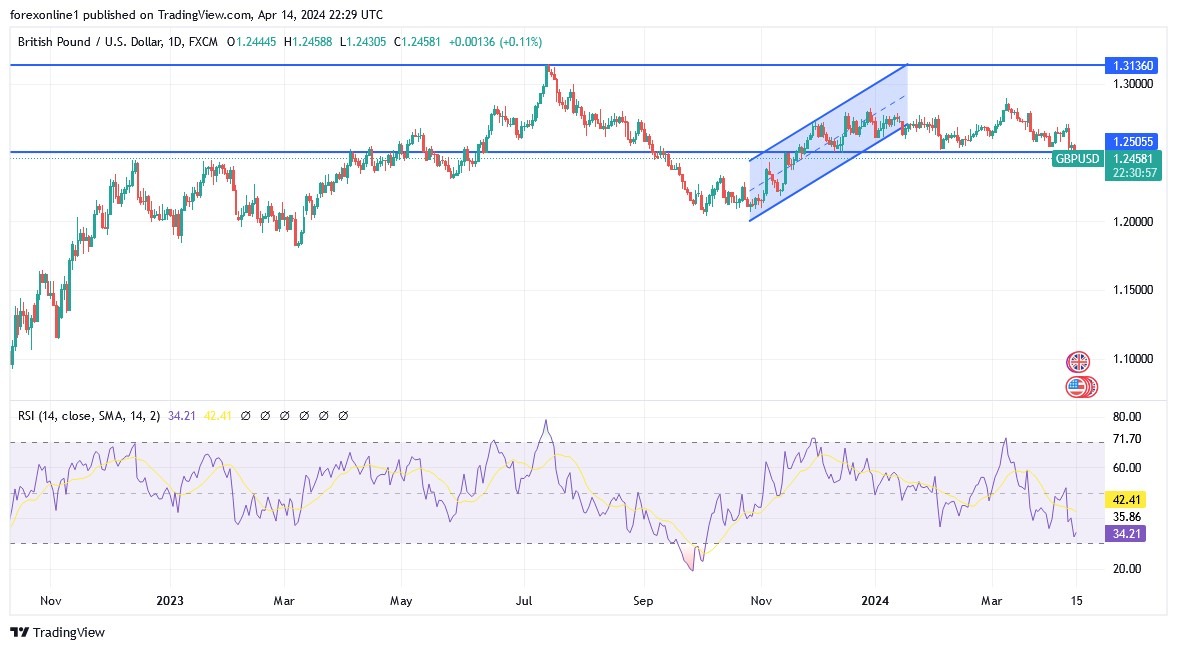- The GBP/USD continued its decline last week as the US Dollar Index (DXY) gained strength.
- It fell to a support level of 1.2426, its lowest level since November last year, as hopes for quick rate cuts by the Federal Reserve faded.
- It started trading this week around the 1.2440 support.
- In general, the GBP/USD joined other major currencies in a significant decline last week after a series of strong US economic data.

According to the results of the economic calendar data, a report from the Bureau of Labor Statistics (BLS) showed that the US economy managed to create more than 300,000 jobs in March while the country's unemployment rate fell to 3.8%. A separate report showed that inflation in the country continued to rise in March. The headline CPI jumped to 3.5% while core inflation rose to 3.8%. There is a possibility that inflation will continue to rise this month as gasoline prices remain high. Obviously, the escalating crisis in the Middle East will further exacerbate the situation. These two figures are of great importance because jobs and inflation are part of the Federal Reserve's dual mandate. Consequently, there is a possibility that the Fed will not implement the rate cuts it had planned in previous meetings. A look at CME data shows that most economists do not expect a rate cut in June as they had previously expected.
Looking ahead, GBP/USD pair will react to a number of important economic data from the UK this week. The Office for National Statistics (ONS) will publish the latest employment figures on Tuesday. More importantly, it will publish consumer and producer inflation figures for March. Economists expect the UK CPI to fall from 3.4% to 3.1% on an annual basis. Core inflation is expected to move to 4.1%.
Generally, there are signs that inflation in Britain will continue to decline as energy prices fall. A report published last week showed that energy prices will fall more than previously expected. Wholesale prices will fall to £82 per megawatt-hour this year, 27% lower than forecast. Therefore, if this trend continues, the Bank of England will likely start cutting interest rates earlier than the US Federal Reserve.
Overall, this is largely the story of the US dollar: we see the dollar strengthening its position as the best-performing currency in 2024, supported by fading hopes for an interest rate hike by the Federal Reserve amid rising US inflation and a resilient labor market. The strength of the US economy highlights the continuing disparity in wealth between the Eurozone and Britain, where the process of lower inflation remains intact due to slowing economic activity and easing labor market conditions. For its part, the European Central Bank indicated last Thursday that based on current trends, it will cut interest rates in June, while the Bank of England may cut interest rates in June or August. Thus, this difference is a strong force for currency dynamics and means that the price of the US dollar can strengthen against the euro and the pound sterling.
Top Forex Brokers
In general, the reduction in expectations for a cut in US interest rates also extended to stock markets, which came back under pressure and strengthened the “safe haven” dollar while affecting the “high” pound sterling through the risk channel. It is a win-win for the US dollar at present.
Technical Forecasts for the GBP/USD pair today:
The GBP/USD price formed a double top pattern around the 1.2830 level between January and March. It has now collapsed below the neckline of this pattern at 1.2520, the low of February 5. Moreover, the pair moved below the 50-day moving average and the Ichimoku cloud indicator. Also, the Relative Strength Index (RSI) is approaching the oversold level at 30. Therefore, the outlook for the pair is very bearish, which could see it fall to the support level at 1.2300.
Ready to trade our daily Forex forecast? Here’s some of the best forex broker UK reviews to check out.
